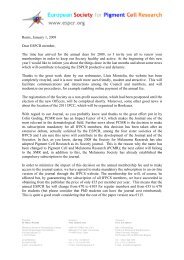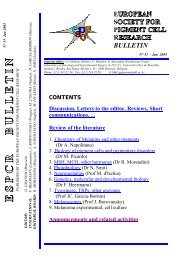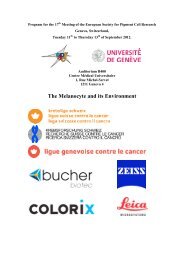espcrbulletin - European Society for Pigment Cell Research
espcrbulletin - European Society for Pigment Cell Research
espcrbulletin - European Society for Pigment Cell Research
You also want an ePaper? Increase the reach of your titles
YUMPU automatically turns print PDFs into web optimized ePapers that Google loves.
antibrowning activities and to seek new tyrosinase inhibitors <strong>for</strong> applications as antibrowning and<br />
depigmenting agents in the food and cosmetic industries. The isolated flavonoids were identified as<br />
liquiritin, licuraside, isoliquiritin, liquiritigenin (from Glycyrrhiza uralensis Fisch.), and<br />
licochalcone A (from Glycyrrhiza inflate Bat.) by UV, MS, (1)H NMR, and (13)C NMR analyses.<br />
The inhibitory potencies and capacities of these flavonoids toward monophenolase activity of<br />
mushroom tyrosinase were investigated. The IC(50) values of licuraside, isoliquiritin, and<br />
licochalcone A <strong>for</strong> monophenolase activity were 0.072, 0.038, and 0.0258 mM, respectively. A<br />
study of the mechanisms of monophenolase inhibition by these flavonoids indicated that they are<br />
all competitive inhibitors. Different from the above flavonoids, no inhibitory activity was observed<br />
<strong>for</strong> liquiritin, whereas liquiritigenin activated the monophenolase activity as a cofactor. The<br />
inhibitory effect of licuraside, isoliquiritin, and licochalcone A on diphenolase activity with l-<br />
DOPA as the substrate was much lower than those with l-tyrosine. Results suggest that licuraside,<br />
isoliquiritin, and licochalcone A have the high potential to be further developed into effective<br />
antibrowning and depigmenting agents.<br />
- Gandia-Herrero F, Escribano J, Garcia-Carmona F.<br />
Characterization of the activity of tyrosinase on betaxanthins derived from (R)-amino acids.<br />
J Agric Food Chem. 53(23):9207-12, 2005.<br />
The activity of tyrosinase (EC 1.14.18.1) on selected (R)-betaxanthins is characterized in depth,<br />
demonstrating that the activity of the enzyme is not restricted to betaxanthins derived from (S)amino<br />
acids. Conversion of (R)-tyrosine-betaxanthin [(R)-portulacaxanthin II] to the pigment (R)dopaxanthin<br />
and its further oxidation to a series of products is described. Compound identity was<br />
studied by high per<strong>for</strong>mance liquid chromatography and electrospray ionization-mass<br />
spectrometry. The reaction rate on the (R)-isomer of dopaxanthin is 1.9-fold lower than that<br />
obtained <strong>for</strong> the (S)-isomer in previous studies. Tyrosinase showed stereospecificity in its affinity<br />
toward betaxanthins. The characterization of the activity of tyrosinase on (R)-betaxanthins<br />
rein<strong>for</strong>ces the role of the enzyme in the biosynthetic scheme of betalains.<br />
- Gandia-Herrero F, Jimenez-Atienzar M, Cabanes J, Garcia-Carmona F, Escribano J.<br />
Differential activation of a latent polyphenol oxidase mediated by sodium dodecyl sulfate. J<br />
Agric Food Chem. 53(17):6825-30, 2005.<br />
A kinetic study of the activity of soluble and membrane-bound latent polyphenol oxidase (PPO)<br />
extracted from beet root (Beta vulgaris) was carried out. For the first time, two types of behavior<br />
(hyperbolic and sigmoid) are reported in the same enzyme <strong>for</strong> PPO activation by the surfactant<br />
sodium dodecyl sulfate (SDS), depending on substrate nature. A kinetic model based on<br />
cooperative systems is developed to describe the activation effect of SDS, enabling the<br />
determination of the number of surfactant molecules binding to the enzyme in the activation<br />
process. The results indicate that the active site of the enzyme is not affected by SDS and that a<br />
stepwise con<strong>for</strong>mational change favors the access of hydrophobic substrates compared to<br />
hydrophilic ones. Differential activation of PPO mediated by SDS may be of relevance in the<br />
control of PPO activity since the enzyme is able to express activity toward a specific substrate<br />
while remaining latent to others.<br />
- Garcia-Molina F, Penalver MJ, Rodriguez-Lopez JN, Garcia-Canovas F, Tudela J.<br />
Enzymatic method with polyphenol oxidase <strong>for</strong> the determination of cysteine and Nacetylcysteine.<br />
J Agric Food Chem. 53(16):6183-9, 2005.<br />
Thiols, such as cysteine and N-acetylcysteine, are included in many pharmaceutical products <strong>for</strong><br />
their mucolytic properties. The method described here uses mushroom polyphenol oxidase (PPO)<br />
to determine two thiols and consists of measuring the lag period in the <strong>for</strong>mation of the product<br />
generated as PPO acts on o-diphenol in the presence of a thiol. In the experimental conditions, oquinone<br />
is <strong>for</strong>med enzymatically and then reacts stoichiometrically with the thiol, originating the<br />
corresponding thiol-diphenol adduct, which does not absorb visible light. Once the thiol has been<br />
used up, the o-quinone can be observed in the medium. It must be borne in mind that the inhibition<br />
1439







